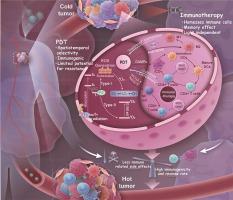当前位置:
X-MOL 学术
›
Coord. Chem. Rev.
›
论文详情
Our official English website, www.x-mol.net, welcomes your feedback! (Note: you will need to create a separate account there.)
Visualized photodynamic nanomaterials activating tumor-associated immune landscape as a next-generation anticancer strategy
Coordination Chemistry Reviews ( IF 20.3 ) Pub Date : 2024-06-25 , DOI: 10.1016/j.ccr.2024.216027 Luyao Tian , Xia Li , Lanping Guo , Luqi Huang , Xiongzhi Wu , Wenyuan Gao
Coordination Chemistry Reviews ( IF 20.3 ) Pub Date : 2024-06-25 , DOI: 10.1016/j.ccr.2024.216027 Luyao Tian , Xia Li , Lanping Guo , Luqi Huang , Xiongzhi Wu , Wenyuan Gao

|
As advances in high-resolution single-cell technology shed light on the complex microenvironment of tumors, the focus of clinical strategies has shifted to single-cell phenotypes in stratified subgroups, and targeting tumor immune-associated landscape strategies may enable more precise treatment modalities. With the elucidation of the tumor landscape, immunotherapy has taken off, but its effectiveness has been hampered by immune escape and the resulting immunological-related side effects. As a result, immunotherapy is invariably studied in concert with other therapies in order to safely and effectively stimulate the anticancer immunity. Photodynamic therapy is unsurpassed in filling gaps in current cancer immunotherapy due to its direct cytotoxic effects, tumor vascular system damage, and generation of a powerful immune response. The mutually reinforcing effects of photodynamic therapy and the tumor-associated immune landscape have been well researched over the years, suggesting that photodynamic therapy combined with targeting tumor landscape strategies can become “magic bullet” in antitumor therapy. However, the inability of conventional drug administration to penetrate malignant tissue and the toxicity of normal tissue owing to passive diffusion have limited their clinical application. Delivery systems based on multifunctional nanomaterials with precise controlled drug release can synergize with other therapies, acting as a bridge to photodynamic immunotherapy. The first thorough and current review of PDT synergistic targeting of tumor-associated immune landscapes employing nanomaterials as bridges is provided in this article. The synergistic therapeutic molecular mechanisms of these nanomaterials, as well as the accompanying design methodologies, are elaborated by following the concept of “from bench to clinic”, covering the latest advanced applications of these nanomaterials, issues in clinical translation, and the outlook.
中文翻译:

可视化光动力纳米材料激活肿瘤相关免疫景观作为下一代抗癌策略
随着高分辨率单细胞技术的进步揭示了肿瘤复杂的微环境,临床策略的重点已转向分层亚组中的单细胞表型,而针对肿瘤免疫相关景观策略可能会实现更精确的治疗方式。随着肿瘤状况的阐明,免疫疗法已经开始兴起,但其有效性受到免疫逃逸和由此产生的免疫相关副作用的阻碍。因此,免疫疗法总是与其他疗法一起研究,以安全有效地刺激抗癌免疫力。光动力疗法由于其直接的细胞毒性作用、肿瘤血管系统损伤以及产生强大的免疫反应,在填补当前癌症免疫疗法的空白方面是无与伦比的。多年来,光动力疗法和肿瘤相关免疫景观的相辅相成的作用已得到充分研究,表明光动力疗法与靶向肿瘤景观策略相结合可以成为抗肿瘤治疗中的“灵丹妙药”。然而,常规给药无法穿透恶性组织以及被动扩散对正常组织的毒性限制了其临床应用。基于具有精确控制药物释放的多功能纳米材料的递送系统可以与其他疗法产生协同作用,充当光动力免疫疗法的桥梁。本文首次对使用纳米材料作为桥梁的肿瘤相关免疫环境的 PDT 协同靶向进行了全面的综述。 遵循“从实验室到临床”的理念阐述了这些纳米材料的协同治疗分子机制以及相应的设计方法,涵盖了这些纳米材料的最新先进应用、临床转化中的问题和展望。
更新日期:2024-06-25
中文翻译:

可视化光动力纳米材料激活肿瘤相关免疫景观作为下一代抗癌策略
随着高分辨率单细胞技术的进步揭示了肿瘤复杂的微环境,临床策略的重点已转向分层亚组中的单细胞表型,而针对肿瘤免疫相关景观策略可能会实现更精确的治疗方式。随着肿瘤状况的阐明,免疫疗法已经开始兴起,但其有效性受到免疫逃逸和由此产生的免疫相关副作用的阻碍。因此,免疫疗法总是与其他疗法一起研究,以安全有效地刺激抗癌免疫力。光动力疗法由于其直接的细胞毒性作用、肿瘤血管系统损伤以及产生强大的免疫反应,在填补当前癌症免疫疗法的空白方面是无与伦比的。多年来,光动力疗法和肿瘤相关免疫景观的相辅相成的作用已得到充分研究,表明光动力疗法与靶向肿瘤景观策略相结合可以成为抗肿瘤治疗中的“灵丹妙药”。然而,常规给药无法穿透恶性组织以及被动扩散对正常组织的毒性限制了其临床应用。基于具有精确控制药物释放的多功能纳米材料的递送系统可以与其他疗法产生协同作用,充当光动力免疫疗法的桥梁。本文首次对使用纳米材料作为桥梁的肿瘤相关免疫环境的 PDT 协同靶向进行了全面的综述。 遵循“从实验室到临床”的理念阐述了这些纳米材料的协同治疗分子机制以及相应的设计方法,涵盖了这些纳米材料的最新先进应用、临床转化中的问题和展望。






































 京公网安备 11010802027423号
京公网安备 11010802027423号